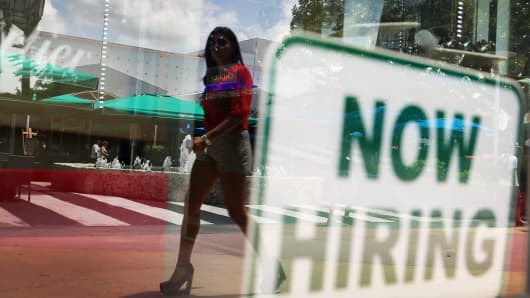August employment growth was also well above the roughly 80,000 monthly jobs that estimates suggest we need to accommodate new workers and keep unemployment from rising. And unemployment did indeed hold steady in August, unchanged at 4.9 percent from its July level. The Federal Reserve is also closely watching wage growth. Hourly and weekly wages both edged up in August for workers overall, while production and non-supervisory workers saw hourly wage increases. However, wage growth was more moderate than in July, as we would expect with slower hiring.
Digging into the industry numbers mostly confirms the positive picture, but there are a few reasons for caution. August employment growth was led by the education and health services sector (+39,000 over the month) and after that by professional and business services (+22,000 over the month). Both have been workhorses of the recovery, and their continued expansion is key to seeing the kind of continued job creation that the economy needs to stay above 80,000 per month.
The private sector diffusion index, which roughly measures how evenly the new jobs added are spread across sectors, was also close to its June and July levels and a bit above where it was a year ago. This means that August's employment growth looked a lot like that in June and July, albeit at a somewhat slower pace.
Seventy-eight months of employment growth is a very long win streak, but in part this was to be expected given the very deep and long recession. Sticking with the industry data, we see a few signs that this tremendous expansion may be slowing. The workhorses of professional and social services were off their growth from a year ago and stepped down from their previous month's pace.
Perhaps more importantly, employment in temporary help services contracted. One month of data is not enough to determine a trend, but this is a closely watched measure that many consider a leading indicator of employment growth. This sector will certainly deserve attention in the next month's report. Also, several high-paying industries for workers without four-year degrees--manufacturing, construction, and mining—continued to slump or vacillate.
Despite these signs of modest cooling, the average monthly employment gain over the prior 12 months was still 204,000, a healthy pace. This suggests that if the recovery is slowing, it is doing so at a gradual pace that continues to make room for new workers added to the economy and for those still re-entering after losing work in the recession.
Commentary by Abigail Wozniak, an associate professor in the Department of Economics at the University of Notre Dame. Her research has examined migration between states and cities as well as employer compensation and screening policies. Professor Wozniak is currently a faculty research fellow at the National Bureau of Economic Research (NBER) and a research fellow at the Institute for the Study of Labor (IZA) in Bonn, Germany. Over 2014-2015, she served as senior economist to the White House Council of Economic Advisers, working on labor economics issues and analyzing employment statistics for the Administration. She was a visiting fellow at Princeton University in 2008-09. She is a graduate of Harvard University (PhD) and the University of Chicago (AB). She is a Wisconsin native and a former associate economist at the Chicago Federal Reserve.
For more insight from CNBC contributors, follow
@CNBCopinion
on Twitter.


